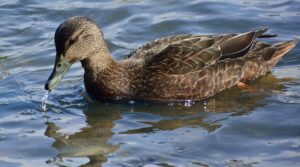 As the mild December rolls along, the time comes for the annual Christmas Bird Counts. Originally begun in the eastern US 124 years ago, they have been conducted in Manitowoc County since 1974, when Bernie Brouchoud first rounded up volunteers to count birds here on behalf of Woodland Dunes. That makes 50 years of winter bird counting, centered in four 15-mile diameter circles in our county, with many thousands of observations of our local birds found here during the winter season. This is one of the first citizen-science projects as they are known, where knowledgeable volunteers collect data which is later used for scientific research. It’s quite a success story, with many thousands of people participating. Last year, more than seventy-nine thousand counters participated in 2,625 counts in the US, Canada, the Caribbean, South America, and on Pacific islands.
As the mild December rolls along, the time comes for the annual Christmas Bird Counts. Originally begun in the eastern US 124 years ago, they have been conducted in Manitowoc County since 1974, when Bernie Brouchoud first rounded up volunteers to count birds here on behalf of Woodland Dunes. That makes 50 years of winter bird counting, centered in four 15-mile diameter circles in our county, with many thousands of observations of our local birds found here during the winter season. This is one of the first citizen-science projects as they are known, where knowledgeable volunteers collect data which is later used for scientific research. It’s quite a success story, with many thousands of people participating. Last year, more than seventy-nine thousand counters participated in 2,625 counts in the US, Canada, the Caribbean, South America, and on Pacific islands.The Manitowoc count took place yesterday, December 28, a cold and rainy day. Well, not cold compared to normal, but the rain made it feel cold. Not a good day for either birds or the counters, but count we did it. We don’t pretend to be able to count every single bird, but we try to survey parks, natural areas, and places birds might hang out in winter. I visited places like Evergreen Cemetery, Manitou and Schuette parks and other spots near the Manitowoc River, and some retention ponds. Between those locations, I kept an eye out for birds along the streets- mourning doves, house sparrows and the like. With abundant fruit on crabapple and hawthorn trees I hoped to find a robin or two, as more and more seem to stay for our mild winters now, but I didn’t find any. Nor could I find the Carolina wren heard on Christmas Eve day- he seemed to have lost his voice in the rain. There were hundreds of ducks and geese on unfrozen ponds, something that was never seen in the colder years early in the Manitowoc count. Still, it was an interesting day, and some uncommon birds were found, like a black duck hanging around with his mallard cousins.
For someone close to nature, the changes in our environment seem gradual, but noticeable. Climate change is one subject which is being studied using data from Christmas bird counts, and personally, I feel the change seems significant. Perhaps my sample size of 30 years isn’t large enough, but I remember some very cold and snowy counts in my early days. And birds that are no longer seen, like evening grosbeaks which now stay to the north. Others have disappeared due to changes in agriculture, like the little gray partridge found in winter farm fields. Habitat change in addition to climate change. And they interact- warm climate favors things like the emerald ash borer (an invasive species brought in through ignorance), which in turn impacts our habitat. And ticks, which are increasing no doubt aided by warmer winters.
I’ve seen a number of changes over the years. As I finish my career in conservation, I’ve been asked what advice I would pass along based on my experience. It would be this: be careful with nature. I think that there is a lot of evidence that we have often jumped in and changed things without knowing what we are doing. We need to be more thoughtful and think about the end result of our actions. We are truly blessed with amazing natural resources surrounding our cities- forests, wetlands, Lake Michigan- and the wildlife here is amazing and resilient if we give it a decent chance. Because this is a special place, and others are now aware of that, we must protect nature, and restore it where it is damaged. Our moderate climate and natural resources will make this a very desirable place to live, something we often take for granted. There will be increasing pressure to reap a harvest of dollars from the land and waters. We need to do that in a way that doesn’t diminish nature. That is the definition of sustainability in an environmental sense. To not do so will make us or our offspring miserable eventually.
I know that my successors at Woodland Dunes will manage this place sustainably- they believe in that. I hope that enough of the rest of us will do the same, by not destroying native natural areas, by planting native trees and shrubs, and treating waterways with respect. And helping each other, with kindness.
The annual Christmas Bird Counts are an annual marker which helps us see the changes to birds, and nature, over time. I hope we care enough to use the information we’ve gathered to help keep our home the special place it is.
Jim Knickelbine
